Ocean Park Pier (1926-1956)
Revised April 6, 1998
The Venice Investment Company and West Coast Theaters acquired Pickering's beach property for $2,000,000 just two weeks after the disastrous 1924 pier fire. The sale was a windfall for Pickering, who took a terrible loss and would have had difficulty financing a new concrete and fireproof pier that Santa Monica would have insisted upon. The new owners got a 50 year lease on the beach property, or at least they thought they did.When they applied for a building permit in mid February, Santa Monica city officials informed them they wouldn't grant a permit but would instead lease the sand which the city claimed the city owned. Santa Monica officials intended to advertise for bids for a pier franchise on their property. The stunned new owners filed for an injunction to stop the bidding.
The auction took place on March 18, 1924. The Venice Investment Company, intent on regaining control of the pier property, out bid several other companies and agreed to pay the city $2000 / month. The next day they announced plans to rebuild the pier at a cost of $3,000,000 and begin work one week later. Other than clearing the site, little was accomplished that spring. Work wouldn't begin in earnest until fall.
Owners of both the Dome and Rosemary Theaters on Ocean Front Walk put higher priority on reopening than the Venice Investment Company did. The Rosemary Theater began operating immediately in temporary quarters on the promenade at Kinney Street. The new 1600 seat Dome Theater, rebuilt in only 23 days, opened on May 30th at the proposed entrance to the pier.
Lick, whose pier resided across the Venice boundary line, was able to begin reconstruction almost immediately. Work on his pier progressed rapidly, and by May 14th the Bon Ton Ballroom was opened. Caryle Stevenson and his orchestra entertained nightly and all day on weekends.
Lick's new pier was basically the same layout as his old pier; the Bon Ton Ballroom, Dodge'em ride and a few concessions on the south side of the pier with space for a roller coaster behind. Lick needed a new coaster for the summer so he contracted Prior and Church to rebuild their famous Giant Dipper coaster on the site formally occupied by the Zip. The 85 feet high ride opened July 4, 1924.
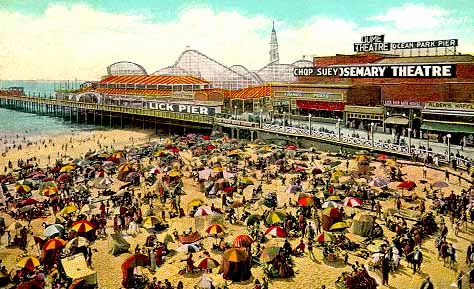
| View looking north of the rebuilt Lick Pier. - 1927 |
By fall 200 men began working on the 960 foot long, 275 foot wide Ocean Park concrete pier. Work progressed steadily and the owners expected it to open for Easter. They built the structure entirely of reinforced concrete and steel. The pier, too, was fireproofed with a concrete deck. Eight fire hydrants were connected to a 200,000 gallon tank on the roof of the Dome Theater. Construction took a few months longer than expected.
The Egyptian Ballroom was the first to open on June 27, 1925. Its interior was a replica in miniature of the temple of Rameses II, King of Egypt. Dance music was provided by Dave Snell's orchestra. Jone's Fun Palace on Ocean Front Walk opened several days later. The large fun house style structure contained slides, rotating barrels, a miniature coaster, various kiddie rides and a large ornate Parker carousel.
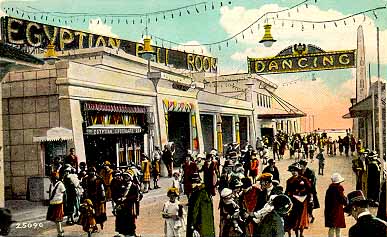
| The Egyptian Ballroom on the Ocean Park Pier. - 1926 |
The Ocean Park Pier celebrated its grand opening with a ten day festival beginning on Saturday August 29, 1925. 100,000 people visited the pier on opening day and watched Jake Cox make a fire dive into a tank of water. New rides included a 75 foot tall Hi-Boy roller coaster, an Aerial Swing, Speedboats, Flying Planes, Toonerville Fun House, Looff carousel, 150 foot high Lighthouse Slide, Miniature Auto Speedway, Rosemary Theater, and a billiards and bowling center.
The pier was doing great business and in 1927 they added new attractions. The Whip and Scooter rides were placed between the Merry-go-round building and the Dome Theater. Other new attractions included the Pig Slide, Freak Slide Show, Captive Aeroplanes, Tango, Rabbit and the Chinatown and Underworld waxworks. The latter was a unique exhibit featuring 29 realistic scenes like a Chinese opium den, a wedding showing slave girls and tong hatchet men, an electrocution at Sing Sing, Brooklyn's black hand kidnapper's in action, crime in the Parisian sewers, and several dramatically portraying beheading and torture scenes.
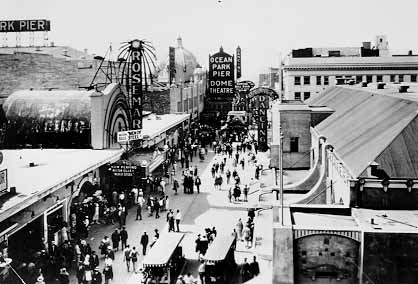
| Ocean Front Walk at the Ocean Park / Lick Piers. - 1927 |
The Ocean Park Pier was expanded for the final time during the summer of 1929. In April the company announced $3,000,000 worth of improvements. They lengthened the pier 500 feet and built five new buildings and attractions. Foremost was a $150,000 Shoot the Shoots ride; the highest amusement chute and the only one ever built on a pier. Its huge pool at the bottom contained 150,000 tons of water. Flat bottom boats made a thrilling decent down a 120 foot high 30 degree sloped water runway into a three foot deep pool. Other rides installed nearby were a Ferris Wheel and an Aero Glider. Jones's Fun Palace was converted into a roller skating rink.
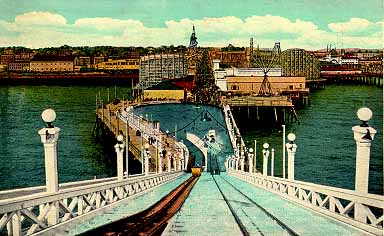
| View inland from the top of the Chutes, a water slide at the seaward end of the pier. - 1929 |
Spending money became scarce once the Depression began in the 1930's. The worst year was 1932, but the Venice / Ocean Park piers didn't begin to recover until the summer of 1935 when the Pacific Electric trolley fare was reduced from 50 cents to 35 cents. Unfortunately it was during that period when the Giant Dipper roller coaster was removed from the Lick Pier. Mike Allmah's Reptile Garden opened on the end of the Ocean Park Pier in 1936 and a Waltzer ride was installed the following year. In 1938 Ed Martine's Diving Bell began operation just inland of the Chutes, and Rudy Illions built another Skooter ride next door to his Looff carousel. A kiddie ride called Fun in Movieland also opened that summer.
The old Egyptian Dance Hall, which had been vacant for some time, became the Sportland Arcade in 1939. Venice Pier's Lindy Loop was moved adjacent to the Hi-Boy coaster and the Fun in the Dark ride next to the Whip began a run that lasted two years. The Bug House mirror maze style fun house replaced it just prior to World War II. Two aerial type rides were placed in the large open area seaward of the Toonerville Fun House.
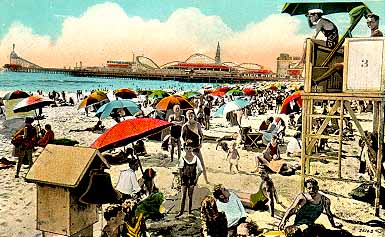
| View looking north from the beach of the Ocean Park / Lick Piers. - 1930 |
Once the World War II ended, the Ocean Park Pier began a period of renovation. First they installed a double Ferris wheel near the end of the pier. Edmund Martine's huge Strat-o-liner, which he had begun in 1941, neared completion. People predicted that its cars attached to the tower's long swivel arms would fly off and land in the ocean.
The Chute the Chutes closed permanently in late summer after an accident claimed the life of a little boy. He stood up and fell out of the boat as it slid down the ramp. Four years later Harry Cooper's Kiddy Town opened at the bottom of the ramp where the pool stood. This enclosed area had a miniature roller coaster, an airplane ride and several small kiddie car rides.
However, these changes did little to increase business or the waning popularity of the old fashioned amusement pier. Teenagers and young adults instead were staying home to watch television or driving their cars to outdoor movie theaters for entertainment. And the closing of the bingo games in 1949 deprived the pier, especially the Lick Pier side, of much of its income.
By 1951 even the Aragon Ballroom had fallen on hard times. The most recent orchestra to play there drew only eight couples. Its manager in one last effort to salvage its declining business hired band leader Lawrence Welk to perform a miracle. Welk's brand of light popular danceable music drew crowds despite the competition of Tommy Dorsey at the nearby Casino Gardens. KTLA was persuaded to resume its telecasts. After it became popular, Dodge dealers became its sponsor and the show became a popular national television show.
In 1956, CBS and the Los Angeles Turf Club decided to convert the decaying Ocean Park Pier into a new $10,000,000 sea themed park and compete with the newly opened Disneyland in Anaheim. They closed the park after Labor Day and hired the best amusement park designers and Hollywood special effects artists to transform the park. It would open in the summer of 1958 as Pacific Ocean Park.